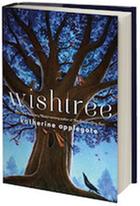
Red is a gregarious, 216-ring-old northern red oak. "Maybe we've met? Oak tree near the elementary school? Big, but not too? Sweet shade in the summer, fine color in the fall?" Although most trees are "not big on chitchat," Red has a story to tell--in addition to his given name, Red is also known as a "wishtree." The original wishtree story is rooted in 1848, when a newly emigrated Irish girl introduced to Red her homeland's custom of tying a wish on a tree. But the "branches" of the story take place in present-day America. Every year, on May first, people come from all over the town to tie scraps of fabric and paper with their hopes and longings to Red's branches: "I wish my gerbil could talk." "I wish for a world without war." "I wish my dad could get better."
Generations of families have lived in the two little houses beneath Red's boughs. "Babies and teenagers, grandparents and great-grandparents. They spoke Chinese and Spanish, Yoruba and English and French Creole. They ate tamales and pani puri, dim sum and fufu and grilled cheese sandwiches.... That's our neighborhood: wild and tangled and colorful." But when a 10-year-old girl named Samar and her Muslim family move in, something is different. People are not as warm and welcoming as they've been with other families from "faraway." Someone throws raw eggs at the house, and children taunt Samar as she walks down the street. But it's not until a teenager carves the word "LEAVE" in Red's trunk that the community--including Red and his animal residents--is stirred to action.
Unfortunately, one of the ripple effects of the commotion is that Francesca, the owner of the land where Red is rooted, starts thinking about cutting him down: "[That tree has] been nothing but trouble for as long as I can remember.... Wishtree or not, this oak is destroying the walkways. Messing with the plumbing, too. Roots go on forever."
As much as he doesn't want to be chopped down, Red is more worried about the animals he shelters and about Samar if he is indeed going to be cut down. He and his best buddy, a crow named Bongo, begin to scheme about helping Samar make a connection to the community, with poignant results.
In Wishtree, Katherine Applegate, beloved author of Newbery-winning The One and Only Ivan (as well as a version for younger kids, Ivan: The Remarkable True Story of the Shopping Mall Gorilla), Crenshaw and the Animorphs series, presents an unusual protagonist in children's literature. Red is funny and wise, in spite of Bongo's eye-rolling entreaties for him to cut the punnish "tree humor" and the "Wise Old Tree routine" when Red gets too platitudinous with his philosophizing. His life has been good, no question about it. Still, he says, "I wanted to make a difference, just a little difference, before I left this lovely world." Having such brutal evidence of the hate that exists in their own town carved into his bark spurs Red on. But, as he says, "What could I possibly do? I had limbs, but they could merely sway. I had a trunk, but it was rooted to the earth. I had a voice, but it could not be used." Even so, Red and Bongo manage to set lasting change in motion through the small steps they can make, and ultimately it's the children--animal and human--that make the wishes of many come true.
The life of a tree is beautifully portrayed throughout Wishtree: "Leaves have cooled picnickers and proposers. Beneath my boughs vows have been made, hearts mended. Nappers have napped; dreamers have dreamed. I've watched ascents attempted, listened to stories spun." It hasn't all been picnics and sweet dreams, though. Red has "aches and pains, like everyone. Last year I had a mite infestation that drove me nuts. Leaf blister, sooty mold, oak wilt, leaf scorch: Been there, done that."
Every one of Applegate's characters is remarkably developed and authentic. Dialogue, especially between Red and Bongo, is as playful and witty and comfortable as one would expect from best friends. On Red's 216th birthday, the two chat:
"Another sproutday," I said. "I still feel like a sapling."
"You don't look a day over a hundred and fifty," Bongo replied. "Best-looking tree on the block."
"I'm really"--I paused for comic effect--"getting up there."
Bongo, who was perched on my lowest branch, sighed. A crow sigh is unmistakable, like a groan from a tiny, cranky old man.
"Tree humor," I explained, just in case Bongo had missed it, although of course she hadn't. Bongo misses nothing. "Because, you know, I'm so tall."
"Really, Red?" Bongo stretched, admiring her lustrous blue-black wings. "That's the best you got for me this morning?"
Readers will adore Red and his friends, laughing out loud at Bongo's pleas to make "deposits" on the heads of certain deserving individuals and at the naming conventions of animals (skunks name themselves after pleasant scents, like FreshBakedBread; barn owls have "sensible, no-fuss names," like Harold; "notoriously forgetful" raccoon mothers skip the traditional monikers, instead going with names like You, You, You and You). The lasting message of Wishtree, though, is one of acceptance. After all, as Red says, "Making others feel safe is a fine way to spend your days." --Emilie Coulter

